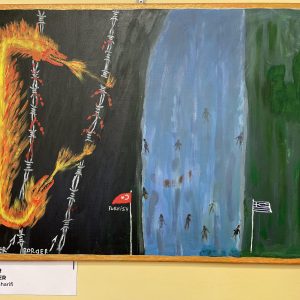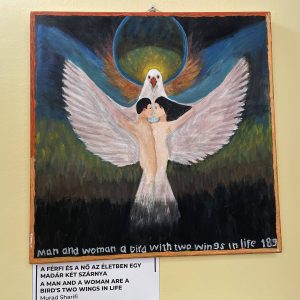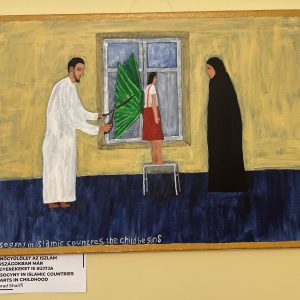Paintings of Murad Sharifi at the Canvases of the Future exhibition
Human Rights Activist and Amateur Painter
A Conversation Murad Sharifi
Translation is available for this content
Váltás magyarraMurad Sharifi considers himself a human rights activist and an amateur painter. To him, the two activities are connected: he also serves the cause of human rights with his pictures. First and foremost, he represents the right of women to have the same, equal opportunities as men. In a country like Afghanistan, his foundation to help women were not well looked upon by extremists even when the Taliban were not in power. We talked to Murad Sharif at the Canvases of the Future exhibition in Budapest’s VIII. District.
What is your favourite painting?
I can’t choose, because every picture represents a new opportunity to shed light on the repressions present in society. Each picture is equally important to me.
Most of your creations show offenses, oppression and injustice against women. How did you start dealing with women’s rights?
I have a daughter and seven sisters; and of course I had a mother. I always felt that they should be on an equal footing with me. I have seen the difficulties they face in their everyday lives. I want women to be able to live in Afghanistan in the same way as in Hungary, for example. I feel it is my responsibility to stand up for women’s rights.
In the current situation in Afghanistan, how much chance do you see for this?
The situation of women in Afghanistan is now particularly critical, and it is no exaggeration to say that we could throw away a thousand years of development. The only way out of this would be through world politics. I don’t see what other options Afghan women could have.
How did painting come into your life?
I don’t consider myself a painter. I’m a complete amateur. I’ve never had any art training. I hadn’t ever held a brush in my hand before. Painting is a completely new tool in my life. When I arrived in Europe, I ran into language difficulties. However, I always had a desire to introduce as many people as possible to what it is like to live in a patriarchal society, and what the situation of women is in Afghanistan. That’s how I got into painting. It helps me avoid language barriers and get my messages across to people.
I used to entrust painters with putting my thoughts and feelings on canvas; but when I took the finished works home, I was unsatisfied. They couldn’t hit exactly what I really wanted to see. That’s why I started to fix the pictures; until I finally realised that I should realise my ideas for myself. I immediately started working with oil paint. I have already made a total of almost a hundred paintings.
What does your creative process look like?
I process all my feelings by starting to paint; I don’t let anything stay inside me. The painting itself does not take long. An image is completed in about a day. What takes a long time, however, is to figure out what symbols to use to convey the message in the painting.
What does painting mean in your life?
My goal with my paintings is that, just like the journalists who describe problems to draw attention to them, I want to shed as much light as possible on what I think are important social issues. I would like my pictures to capture these, and become part of history.








